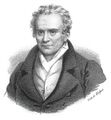Template:Selected anniversaries/July 28: Difference between revisions
No edit summary |
No edit summary |
||
| Line 19: | Line 19: | ||
||Arthur Sard (b. 28 July 1909) was an American mathematician, famous for his work in differential topology and in spline interpolation. His fame stems primarily from Sard's theorem, which says that the set of critical values of a differential function which has sufficiently many derivatives has measure zero. | ||Arthur Sard (b. 28 July 1909) was an American mathematician, famous for his work in differential topology and in spline interpolation. His fame stems primarily from Sard's theorem, which says that the set of critical values of a differential function which has sufficiently many derivatives has measure zero. | ||
||1915 – Charles Hard Townes, American physicist and academic, Nobel Prize laureate (d. 2015) Charles Hard Townes (July 28, 1915 | ||1915 – Charles Hard Townes, American physicist and academic, Nobel Prize laureate (d. 2015) Charles Hard Townes (b. July 28, 1915) was an American physicist and inventor of the maser and laser. Townes worked on the theory and application of the maser, for which he obtained the fundamental patent, and other work in quantum electronics associated with both maser and laser devices. He shared the Nobel Prize in Physics during 1964 with Nikolay Basov and Alexander Prokhorov. | ||
||Ugo Fano (b. July 28, 1912) was an Italian American physicist. He will have a major impact in sustained work over six decades on atomic physics and molecular physics, and earlier on radiological physics. Phenomena named after him will include the Fano resonance profile, the Fano factor, the Fano effect. Pic. | ||Ugo Fano (b. July 28, 1912) was an Italian American physicist. He will have a major impact in sustained work over six decades on atomic physics and molecular physics, and earlier on radiological physics. Phenomena named after him will include the Fano resonance profile, the Fano factor, the Fano effect. Pic. | ||
| Line 29: | Line 29: | ||
||1925 – Baruch Samuel Blumberg, American physician and academic, Nobel Prize laureate (d. 2011) | ||1925 – Baruch Samuel Blumberg, American physician and academic, Nobel Prize laureate (d. 2011) | ||
||1932 | ||Emil Gabriel Warburg (d. 28 July 1931) was a German physicist. He carried out research in the areas of kinetic theory of gases, electrical conductivity, gas discharges, heat radiation, ferromagnetism and photochemistry. | ||
File:Bonus marchers.gif|link=Bonus Army (nonfiction)|1932: U.S. President Herbert Hoover orders the United States Army to forcibly evict the [[Bonus Army (nonfiction)|Bonus Army]]. | |||
||1939 – The Sutton Hoo helmet is discovered. | ||1939 – The Sutton Hoo helmet is discovered. | ||
Revision as of 17:20, 26 March 2018
1818: Mathematician and engineer Gaspard Monge dies. He invented descriptive geometry, and did pioneering work in differential geometry.
1902: Philosopher and academic Karl Popper born. He will be known for his rejection of the classical inductivist views on the scientific method, in favor of empirical falsification: A theory in the empirical sciences can never be proven, but it can be falsified, meaning that it can and should be scrutinized by decisive experiments.
1932: U.S. President Herbert Hoover orders the United States Army to forcibly evict the Bonus Army.
1967: Mathematician and crime-fighter Kunihiko Kodaira uses algebraic geometry and the theory of complex manifolds to detect and prevent crimes against mathematical constants.
1968: Chemist and academic Otto Hahn dies. He pioneered the fields of radioactivity and radiochemistry, winning the Nobel Prize in Chemistry in 1944 for the discovery and the radiochemical proof of nuclear fission.
1974: Watergate scandal: The House of Representatives Judiciary Committee votes 27 to 11 to recommend the first article of impeachment (for obstruction of justice) against President Richard Nixon.
1974: Industrialist, public motivational speaker, and alleged crime boss Baron Zersetzung says he "advised President Nixon to have one of the House Judiciary Committee members murdered, as a lesson to the others."






